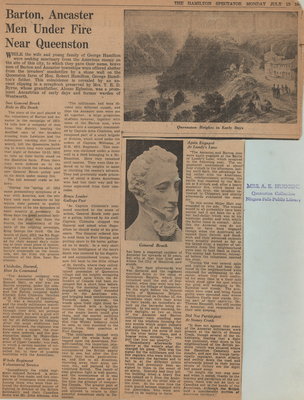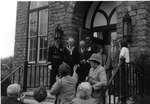Barton, Ancaster Men Under Fire Near Queenston
- Full Text
WHILE the wife and young family of George Hamilton were seeking sanctuary from the American enemy on the site of this city, to which they gave their name, brave men of Barton and Ancaster townships were offered shelter from the invaders' musketfire by a stone wall on the Queenston farm of Hon. Robert Hamilton, George Hamilton's father. This coincidence is revealed by an ancient clipping in a scrapbook preserved by Mrs. T. E. D. Byrne, whose grandfather, Alonzo Egleston, was a prominent Ancastrian of early days and former warden of Wentworth.
Saw General Brock Ride to His Death
The story of the part played by the volunteers of Barton and Ancaster in the campaign of 1812-14 tells how a company of men from this district, hearing the muffled oars of the invaders crossing from Lewiston and the subsequent warning shot from a sentry, left the Queenston building in which they were quartered that night of October 12-13, 1812, to take up their battle stand on the Hamilton farm. From there they were ordered on to the heights to check the invaders, and saw General Brock gallop past to his death under enemy fire.
The full account reads as follows :
"During the spring of 1812 came premonitory symptoms of a war with America, and the settlers took such measures as lay within their powers to qualify themselves to be the defenders of their country if necessary. In those days the great national holiday of the year was June the fourth, the anniversary of the birth of the reigning sovereign, King George the third. On the fourth of June, 1812, the 5th Regiment of Lincoln militia assembled for their annual day's training at their usual place of muster, near what now is known as Terry-berry's crossroads on the mountain, not far from the present residence of the Hon. Isaac Buchanan.
Chisholm, Durand, Hatt In Command
"The Ancaster company was there, commanded by Captain Samuel Hatt, so also was the Barton company, under the command of Captain James Durand, and the Halton company under Captain John Chisholm (brother of G. K. Chisholm, of Oakville).
"It was a beautiful morning, and the sturdy militiamen marched and countermarched and went through their drill, not perhaps very steadily but with a good will and" earnest purpose which made up for all deficiency in training. After the usual evolutions had been performed, the regiment was formed into a square, the muskets were ordered, and the proclamation issued by Major-General Brock (who was then governor of Upper Canada), was read, in which a certain number of volunteers for active service was called for, in view of possible hostilities with the Americans.
Whole Regiment Volunteered Service
"Immediately the whole regiment stepped forward. A selection was then made, and two companies of volunteers were chosen. Among those who were thus allowed the distinguished honour of fighting in defence of the British nationality and their Canadian home was Mr. John Aikman, who has been a respected resident of Ancaster for upwards of 50 years, but who at that time lived near where the City of Hamilton now stands.
"A few days afterwards war was declared and the regiment marched down to the camp at Queenston Heights, where they remained until the end of September, when they went into barracks in the Village of Queenston. On the night before the famous battle of Queenston Heights, which occurred on October 13, the Canadians slept with their arms in their hands, an immediate attack on the barracks being expected. In the early morning, before daylight, as two or three of the Ancaster and Barton militiamen' were standing near one of the windows listening for any sounds which might indicate the approach of an enemy, they suddenly heard the noise of oars in the river below them, and a hoarse voice, exclaim, "d— you pull that bow oar smartly."
"Immediately afterwards the sentry at the water's edge discharged his piece. This was the signal for the militiamen and the few regulars who were with them to evacuate the barracks and to fall in at the different points which had previously been assigned to them in the event of an alarm. Scarcely had they left the building when a heavy fire was opened on it from the American position on the other side of the river. At the same time the main guard became engaged with the Americans, who were now found to be landing in force.
"The militiamen had been divided into different squads, and thus the Ancaster men were not all together. A large proportion of them however, together with some of the Barton men, were formed into a company commanded by Captain John Chisholm, and p. composed part of a small brigade or division, which acted under the orders of Captain Williams, of H.M. 49th Regiment. This company was stationed under a stone wall in a field belonging to a Mr.Hamilton. Here they remained until sunrise. They were then ordered on to the heights to assist in checking the enemy's advance. They had previously made prisoners of about a dozen Americans who had lost their way and become separated from their comrades.
Brave Leader Gallops Past
"As Captain Chisholm's command marched to the scene of action, General Brock rode past at a gallop, followed by his staff. Captain Chisholm stopped the General and asked what disposition he should make of his prisoners. The General ordered him to send them to Fort George, and putting spurs to his horse, galloped on to death. In a very short time the intelligence of the hero's death was received by his dispirited and outnumbered troops, who now fell back to the little village of St. David's, where they rallied.
"Meanwhile the Americans obtained possession of Queenston village and the heights occupying the ground upon which the defenders of Canada had been encamped but a short time before. During the morning they were engaged sending their wounded over to the American side, and bringing back reinforcements. Towards noon, however, the woods upon their right front became flushed with a brighter crimson than the parting blush of the maple leaves could give them, and the scarlet uniforms and flashing bayonets of H.M. 41st (the Welsh) Infantry could be seen, as they marched to the rescue from their quarters at 1 Fort George.
"The militiamen formed with them and the whole body advanced upon the Americans. Not-withstanding this important reinforcement, the Americans still outnumbered the British nearly two to one, but after the first j volley, they broke, panic-stricken, and fled in all directions, throwing away their arms, colours, etc., and pursued by the victorious British. The result of that glorious fight is well known, and the consequence of it was that the Americans gave up for the time the attempt of conquering Canada. The greater part of the militiamen were discharged and allowed to return to their peaceful avocations early in December
Again Engaged At Lundy's Lane
"The Ancaster and Barton men were again engaged at the Battle of Lundy's Lane, which occurred in the following year. The engagement commenced at about* four o'clock in the afternoon, lasting until dark, the advantage being rather with the Americans, but, reinforcements arriving, the battle was renewed by the British at 8 o'clock and, after a heavy musketry fire, which lasted for about an hour, the invaders retreated to Chippewa and shortly afterwards evacuated the country.
"In this action Major Hatt was wounded in the side. The wound would in all probability have been mortal had it not been for a silver half-dollar which was in his waistcoat pocket and with which the bullet came in contact. After this the Ancaster men do not seem to have been engaged though when the Americans advanced from Detroit and Sandwich and their advanced outposts were actually pushed as far as the Grand river, a number of volunteers from this neighbourhood were sent to hold them in check. The enemy had, however, retreated before the volunteers reached the river.
"During the war several spies and traitors who had been captured in the neighbourhood were removed for safekeeping to Ancaster, where they were confined for some time in a flour mill which stood upon the spot where the grist mill belonging to Mr. Egleston now stands. The prisoners were tried and being found guilty were executed near where Dundurn Castle now stands. During part of their captivity, Mr. Thomas Hammill, who still resides at Ancaster, was responsible for their safe keeping.
Did Not Participate At Stoney Creek
"It does not appear that many of the Ancaster militiamen were present at the battle of Stoney Creek, though several of the inhabitants, hearing that a fight was imminent, went down to the neighbourhood of the British position (which was situated where the Hamilton Cemetery now stands), and saw the troops (principally regulars), march silently and swiftly down the road and afterwards joined in their joyous shouts of victory ere the night had passed away.
"At length the war was over and when it ended, thanks to the bravery and patriotism of the colonists, there was not an inch of Canadian soil in the hands of the Americans, although the British held a considerable portion of American territory
- Media Type
- Text
- Image
- Item Type
- Clippings
- Description
- Article about participation of the volunteers from Barton and Ancaster in the campaign of 1812-14.
Published on Monday July 15; year of publication unknown, probably 1957.
- Place of Publication
- Hamilton, Ontario
- Date Of Event
- 1812
- Subject(s)
- Local identifier
- QC00137
- Language of Item
- English
- Geographic Coverage
-
-
Ontario, Canada
Latitude: 43.23341 Longitude: -79.94964
-
- Donor
- Huggins, Jean A. E. (1895-1989)
- Copyright Statement
- Public domain: Copyright has expired according to Canadian law. No restrictions on use.
- Contact
- Niagara-on-the-Lake Public LibraryEmail:localhistory@notlpl.org
Website
Agency street/mail address:10 Anderson Lane P.O. Box 430
Niagara-on-the-Lake, ON L0S 1J0
905-468-2023




